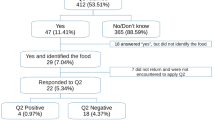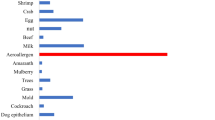Abstract
Background
Although the number of studies on allergic diseases in the general population of southern China is increasing, only a few have addressed food allergy (FA) in children in this region. The present study aimed to investigate the prevalence, clinical manifestations, spectrum of allergens, and related risk factors of FA in preschool children in Guangdong Province, southern China.
Methods
A random cluster-sampling method was used to select 24 kindergartens from 12 cities in Guangdong Province. The parents or guardians of the children were requested to complete a questionnaire on general information and data regarding FA diagnosis and symptoms in the children and their first-degree relatives. Thereafter, the Chi-square test, multivariate regression analysis, and Spearman’s rank-order correlation coefficient analysis were performed to identify statistically significant differences.
Results
Analysis of 2540 valid questionnaires revealed an FA prevalence rate of 4%. Adverse food reactions were due to the consumption of shrimp (4.4%), crab (3.2%), mango (2.3%), cow’s milk and dairy products (1.9%), and eggs (1.4%). Logistic regression analysis indicated that a history of FA and a history of allergic rhinitis in the first-degree relatives were the major factors leading to FA in children.
Conclusions
The incidence of FA in children in Guangdong Province is higher than that commonly believed. An individual’s genetic background is an important risk factor for FA. Hence, mitigation of the impact of lifestyle and environmental factors should be carefully considered to reduce the incidence of childhood FA.
Similar content being viewed by others
References
Wu AY. Immunotherapy-Vaccines for allergic diseases. J Thorac Dis 2012;4:198–202.
Sampson HA. Update on food allergy. J Allergy Clin Immunol 2004;113:805–819; quiz 820.
Branum AM, Lukacs SL. Food allergy among children in the United States. Pediatrics 2009;124:1549–1555.
Branum AM, Lukacs SL. Food allergy among U.S. children: trends in prevalence and hospitalizations. NCHS Data Brief 2008:1–8.
Grundy J, Matthews S, Bateman B, Dean T, Arshad SH. Rising prevalence of allergy to peanut in children: data from 2 sequential cohorts. J Allergy Clin Immunol 2002;110:784–789.
Chafen JJ, Newberry SJ, Riedl MA, Bravata DM, Maglione M, Suttorp MJ, et al. Diagnosing and managing common food allergies: a systematic review. JAMA 2010;303:1848–1856.
Gupta RS, Springston EE, Warrier MR, Smith B, Kumar R, Pongracic J, et al. The prevalence, severity, and distribution of childhood food allergy in the United States. Pediatrics 2011;128:9–17.
Lin RY, Anderson AS, Shah SN, Nurruzzaman F. Increasing anaphylaxis hospitalizations in the first 2 decades of life: New York State, 1990–2006. Ann Allergy Asthma Immunol 2008;101:387–393.
Yocum MW, Butterfield JH, Klein JS, Volcheck GW, Schroeder DR, Silverstein MD. Epidemiology of anaphylaxis in Olmsted County: a population-based study. J Allergy Clin Immunol 1999;104:452–456.
Ortolani C, Bruijnzeel-Koomen C, Bengtsson U, Bindslev-Jensen C, Björkstén B, Høst A, et al. Controversial aspects of adverse reactions to food. European Academy of Allergology and Clinical Immunology (EAACI) Reactions to Food Subcommittee. Allergy 1999;54:27–45.
Hu W, Grbich C, Kemp A. When doctors disagree: a qualitative study of doctors’ and parents views on the risks of childhood food allergy. Health Expect 2008;11:208–219.
Gupta RS, Springston EE, Smith B, Kim JS, Pongracic JA, Wang X, et al. Food allergy knowledge, attitudes, and beliefs of parents with food-allergic children in the United States. Pediatr Allergy Immunol 2010;21:927–934.
Ho MH, Lee SL, Wong WH, Ip P, Lau YL. Prevalence of self-reported food allergy in Hong Kong children and teens-a population survey. Asian Pac J Allergy Immunol 2012;30:275–284.
Chen J, Liao Y, Zhang HZ, Zhao H, Chen J, Li HQ. Prevalence of food allergy in children under 2 years of age in three cities in China. Zhonghua Er Ke Za Zhi 2012;50:5–9. [In Chinese]
Leung TF, Yung E, Wong YS, Lam CW, Wong GW. Parentreported adverse food reactions in Hong Kong Chinese pre schoolers: epidemiology, clinical spectrum and risk factors. Pediatr Allergy Immunol 2009;20:339–346.
Asher MI, Weiland SK. The International Study of Asthma and Allergies in Childhood (ISAAC). ISAAC Steering Committee. Clin Exp Allergy 1998;28 Suppl 5:52–66; discussion 90-91.
International study of asthma and allergies in childhood. Phase II modules. Munster, Germany, 1998. http://isaac.auckland.ac.nz/phases/phasetwo/phasetwomodules.pdf (accessed January 27, 2015).
Baek JO, Hong S, Son DK, Lee JR, Roh JY, Kwon HJ. Analysis of the prevalence of and risk factors for atopic dermatitis using an ISAAC questionnaire in 8750 Korean children. Int Arch Allergy Immunol 2013;162:79–85.
Wong GW, Leung TF, Ma Y, Liu EK, Yung E, Lai CK. Symptoms of asthma and atopic disorders in preschool children: prevalence and risk factors. Clin Exp Allergy 2007;37:174–179.
Osborn DA, Sinn J. Soy formula for prevention of allergy and food intolerance in infants. Cochrane Database Syst Rev 2006:003741.
Szajewska H, Horvath A. Meta-analysis of the evidence for a partially hydrolyzed 100% whey formula for the prevention of allergic diseases. Curr Med Res Opin 2010;26:423–437.
Niggemann B, Rolinck-Werninghaus C, Mehl A, Binder C, Ziegert M, Beyer K. Controlled oral food challenges in childrenwhen indicated, when superfluous? Allergy 2005;60:865–870.
Cohen BL, Noone S, Muñoz-Furlong A, Sicherer SH. Development of a questionnaire to measure quality of life in families with a child with food allergy. J Allergy Clin Immunol 2004;114:1159–1163.
Niggemann B, Rolinck-Werninghaus C, Mehl A, Binder C, Ziegert M, Beyer K. Controlled oral food challenges in childrenwhen indicated, when superfluous? Allergy 2005;60:865–870.
Leung TF, Lam CW, Chan IH, Li AM, Tang NL. Sensitization to common food allergens is a risk factor for asthma in young Chinese children in Hong Kong. J Asthma 2002;39:523–529.
Asero R, Ballmer-Weber BK, Beyer K, Conti A, Dubakiene R, Fernandez-Rivas M, et al. IgE-mediated food allergy diagnosis: current status and new perspectives. Mol Nutr Food Res 2007;51:135–147.
Boyce JA, Assa’ad A, Burks AW, Jones SM, Sampson HA, Wood RA, et al. Guidelines for the Diagnosis and Management of Food Allergy in the United States: Summary of the NIAID-Sponsored Expert Panel Report. J Allergy Clin Immunol 2010;126:1105–1118.
Goh DL, Lau YN, Chew FT, Shek LP, Lee BW. Pattern of foodinduced anaphylaxis in children of an Asian community. Allergy 1999;54:84–86.
Chiang WC, Kidon MI, Liew WK, Goh A, Tang JP, Chay OM. The changing face of food hypersensitivity in an Asian community. Clin Exp Allergy 2007;37:1055–1061.
Sicherer SH, Muñoz-Furlong A, Burks AW, Sampson HA. Prevalence of peanut and tree nut allergy in the US determined by a random digit dial telephone survey. J Allergy Clin Immunol 1999;103:559–562.
Eigenmann PA, Calza AM. Diagnosis of IgE-mediated food allergy among Swiss children with atopic dermatitis. Pediatr Allergy Immunol 2000;11:95–100.
O’B-Hourihane J. The threshold concept in food safety and its applicability to food allergy. Allergy 2001;56 Suppl 67:86–90.
Sicherer SH, Muñoz-Furlong A, Sampson HA. Prevalence of peanut and tree nut allergy in the United States determined by means of a random digit dial telephone survey: a 5-year followup study. J Allergy Clin Immunol 2003;112:1203–1207.
Sicherer SH, Muñoz-Furlong A, Sampson HA. Prevalence of seafood allergy in the United States determined by a random telephone survey. J Allergy Clin Immunol 2004;114:159–165.
Lee SI, Shin MH, Lee HB, Lee JS, Son BK, Koh YY, et al. Prevalences of symptoms of asthma and other allergic diseases in korean children: a nationwide questionnaire survey. J Korean Med Sci 2001;16:155–164.
Sun BQ, Zheng PY, Zhang XW, Huang HM, Chen DH, Zeng GQ. Prevalence of allergen sensitization among patients with allergic diseases in Guangzhou, southern China: a four-year observational study. Multidiscip Respir Med 2014;9: 2.
Sun B, Zheng P, Wei N, Huang H, Zeng G. Co-sensitization to silkworm moth (Bombyx mori) and 9 inhalant allergens among allergic patients in Guangzhou, southern China. PLoS One 2014;9: 94776.
Sun BQ, Chende H, Zheng PY, Huang HM, Luo WT, Zeng GQ, et al.Allergy-related evidences in relation to serum IgE: data from the China state key laboratory of respiratory disease, 2008–2013. Biomed Environ Sci 2014;27:495–505.
Bergmann RL, Wahn U, Bergmann KE. The allergy march: from food to pollen. Environ Toxicol Pharmacol 1997;4:79–83.
Saarinen UM, Kajosaari M. Breastfeeding as prophylaxis against atopic disease: prospective follow-up study until 17 years old. Lancet 1995;346:1065–1069.
Kaza U, Knight AK, Bahna SL. Risk factors for the development of food allergy. Curr Allergy Asthma Rep 2007;7:182–186.
Høst A, Halken S. Primary prevention of food allergy in infants who are at risk. Curr Opin Allergy Clin Immunol 2005;5:255–259.
Venter C, Pereira B, Grundy J, Clayton CB, Arshad SH, Dean T. Prevalence of sensitization reported and objectively assessed food hypersensitivity amongst six-year-old children: a population-based study. Pediatr Allergy Immunol 2006;17:356–363.
Author information
Authors and Affiliations
Corresponding author
Rights and permissions
About this article
Cite this article
Zeng, GQ., Luo, JY., Huang, HM. et al. Food allergy and related risk factors in 2540 preschool children: an epidemiological survey in Guangdong Province, southern China. World J Pediatr 11, 219–225 (2015). https://doi.org/10.1007/s12519-015-0030-6
Received:
Accepted:
Published:
Issue Date:
DOI: https://doi.org/10.1007/s12519-015-0030-6




